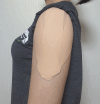Effectiveness of Shoulder Taping in Treating Hemiplegic Shoulder Subluxation: A Randomized Controlled Study of 35 Patients
- PMID: 38820090
- PMCID: PMC11149471
- DOI: 10.12659/MSM.944222
Effectiveness of Shoulder Taping in Treating Hemiplegic Shoulder Subluxation: A Randomized Controlled Study of 35 Patients
Abstract
BACKGROUND Shoulder subluxation in patients with stroke impairs recovery and quality of life. Kinesiology tape is elastic and water-resistant, is commonly used to prevent musculoskeletal injury, and is increasing in use for rehabilitation of patients requiring neurological or physical rehabilitation. This study included 35 patients with shoulder subluxation following stroke and aimed to compare outcomes from standard physical therapy with and without shoulder kinesiology taping. MATERIAL AND METHODS This randomized controlled study involved 35 participants. The patients were randomized into a shoulder kinesiology taping group (n=18) or sham taping group (n=17). All patients underwent a conventional rehabilitation exercise program 5 days a week for 6 weeks. Half of the patients underwent shoulder kinesiology taping, and the other half underwent sham taping. Pre- and post-assessment scores were recorded for all participants for shoulder subluxation distance (SSD), active range of motion (AROM), visual analog scale (VAS), shoulder pain and disability index (SPADI), and modified Barthel index (MBI). RESULTS After the intervention, SSD, AROM, VAS, SPADI, and MBI improved significantly in the shoulder kinesiology taping and sham taping groups (P<0.05). Also, the shoulder kinesiology taping group showed more effective changes in SSD, AROM, VAS, SPADI, and MBI than the sham taping group (P<0.05). CONCLUSIONS These results suggest that the shoulder kinesiology taping is effective in improving SSD, AROM, VAS, SPADI, and MBI in patients with hemiplegic shoulder subluxation.
Conflict of interest statement
Figures



Similar articles
-
The Effect of Kinesiology Taping on the Hemiplegic Shoulder Pain: A Randomized Controlled Trial.J Healthc Eng. 2018 Dec 10;2018:8346432. doi: 10.1155/2018/8346432. eCollection 2018. J Healthc Eng. 2018. PMID: 30651946 Free PMC article. Clinical Trial.
-
Effect of kinesiology taping on hemiplegic shoulder pain and functional outcomes in subacute stroke patients: a randomized controlled study.Eur J Phys Rehabil Med. 2016 Dec;52(6):774-781. Epub 2016 Aug 30. Eur J Phys Rehabil Med. 2016. PMID: 27575012 Clinical Trial.
-
Effects of Kinesio taping for stroke patients with hemiplegic shoulder pain: A double-blind, randomized, placebo-controlled study.J Rehabil Med. 2017 Mar 6;49(3):208-215. doi: 10.2340/16501977-2197. J Rehabil Med. 2017. PMID: 28233009 Clinical Trial.
-
Systematic Review on Effectiveness of shoulder taping in Hemiplegia.J Stroke Cerebrovasc Dis. 2019 Jun;28(6):1463-1473. doi: 10.1016/j.jstrokecerebrovasdis.2019.03.021. Epub 2019 Apr 5. J Stroke Cerebrovasc Dis. 2019. PMID: 30956057
-
Effect of kinesio taping on hemiplegic shoulder pain: A systematic review and meta-analysis of randomized controlled trials.Clin Rehabil. 2021 Mar;35(3):317-331. doi: 10.1177/0269215520964950. Epub 2020 Oct 16. Clin Rehabil. 2021. PMID: 33063559
Cited by
-
Observation of risk factors for shoulder subluxation after stroke using ultrasonography to measure thickness of the supraspinatus muscle: a cross-sectional study.Front Neurol. 2025 Mar 19;16:1532004. doi: 10.3389/fneur.2025.1532004. eCollection 2025. Front Neurol. 2025. PMID: 40177404 Free PMC article.
References
-
- Wanklyn P, Forster A, Young J. Hemiplegic shoulder pain (HSP): Natural history and investigation of associated features. Disabil Rehabil. 1996;18(10):497–501. - PubMed
-
- Lindgren I, Jonsson AC, Norrving B, et al. Shoulder pain after stroke: A prospective population-based study. Stroke. 2007;38(2):343–48. - PubMed
-
- Chae J, Mascarenhas D, David TY, et al. Poststroke shoulder pain: Its relationship to motor impairment, activity limitation, and quality of life. Arch Phys Med Rehabil. 2007;88(3):298–301. - PubMed
-
- Gilmore PE, Spaulding SJ, Vandervoort AA. Hemiplegic shoulder pain: Implications for occupational therapy treatment. Can J Occup Ther. 2004;71(1):36–46. - PubMed
Publication types
MeSH terms
LinkOut - more resources
Full Text Sources
Medical

